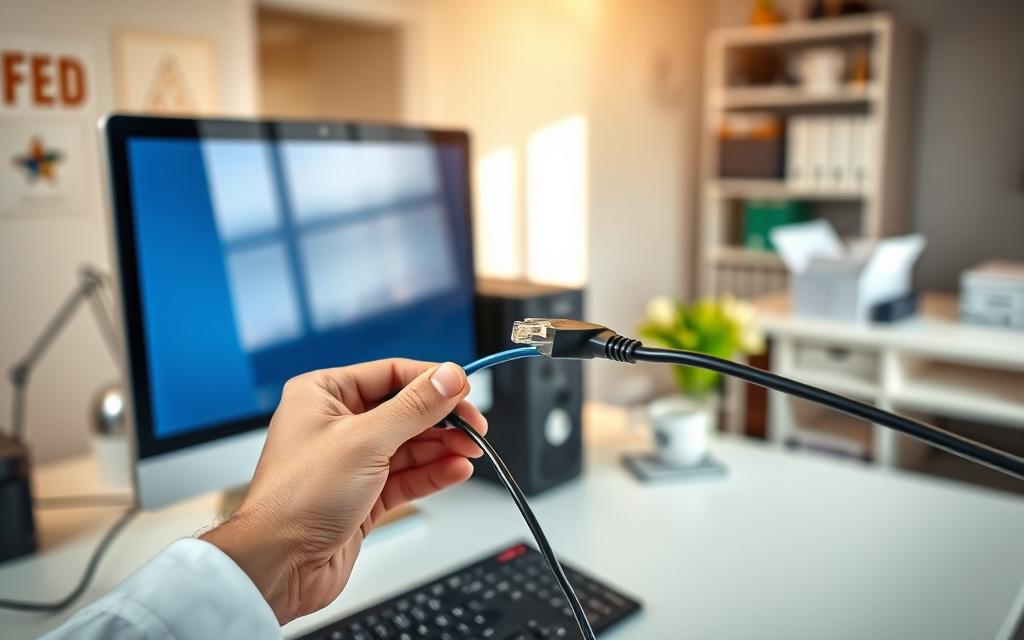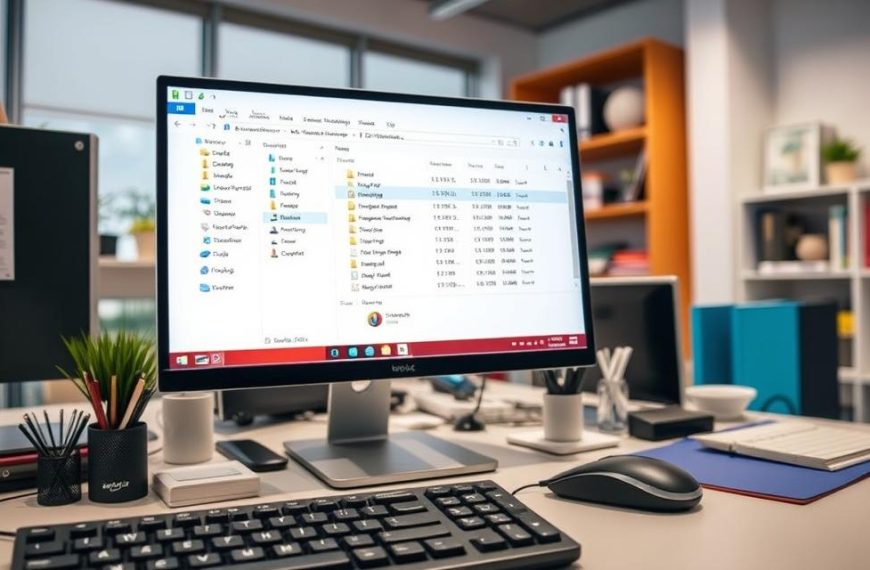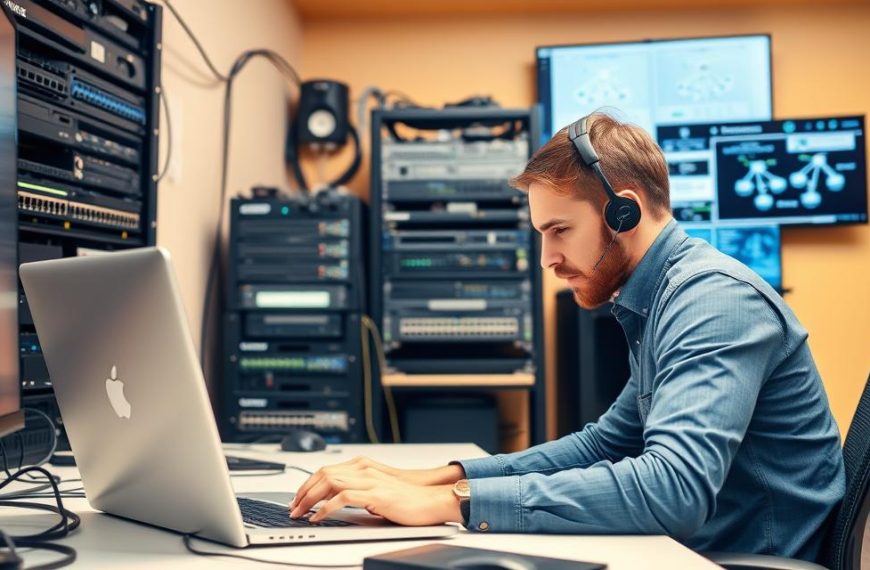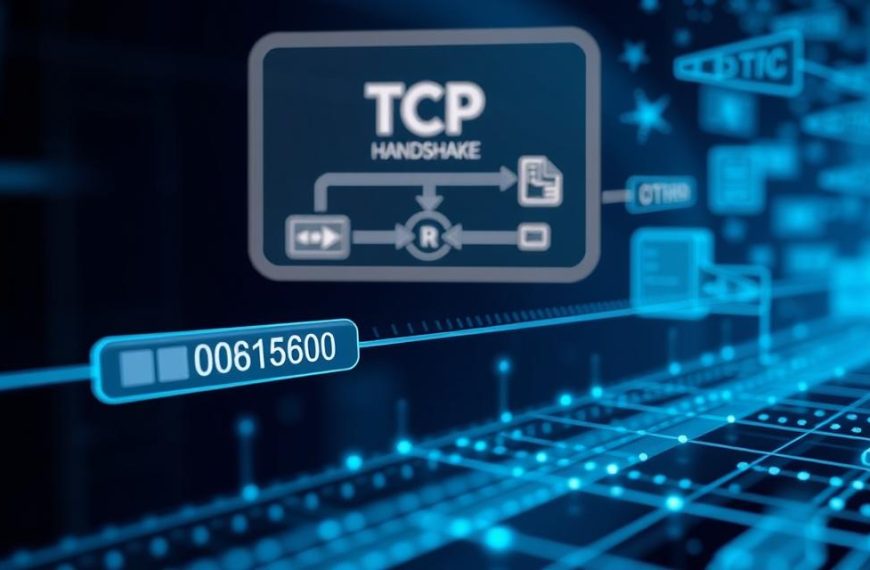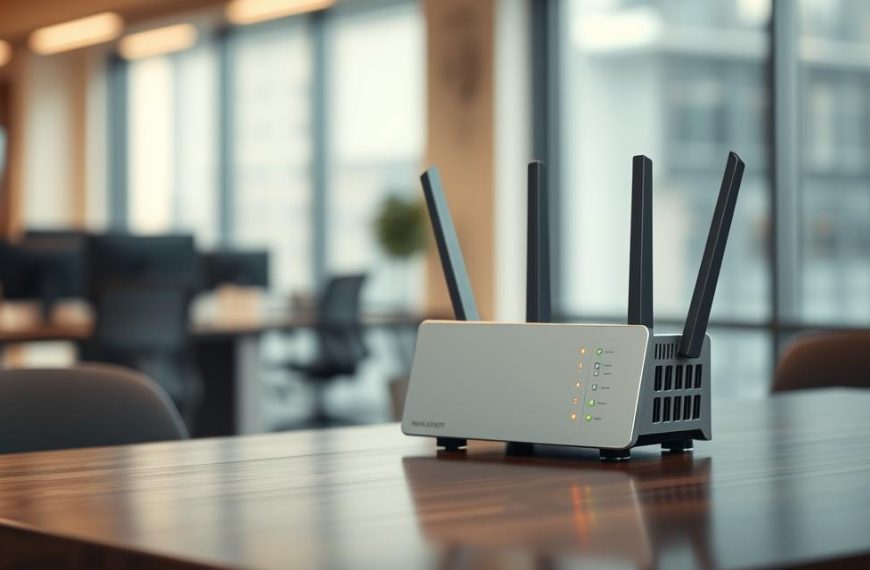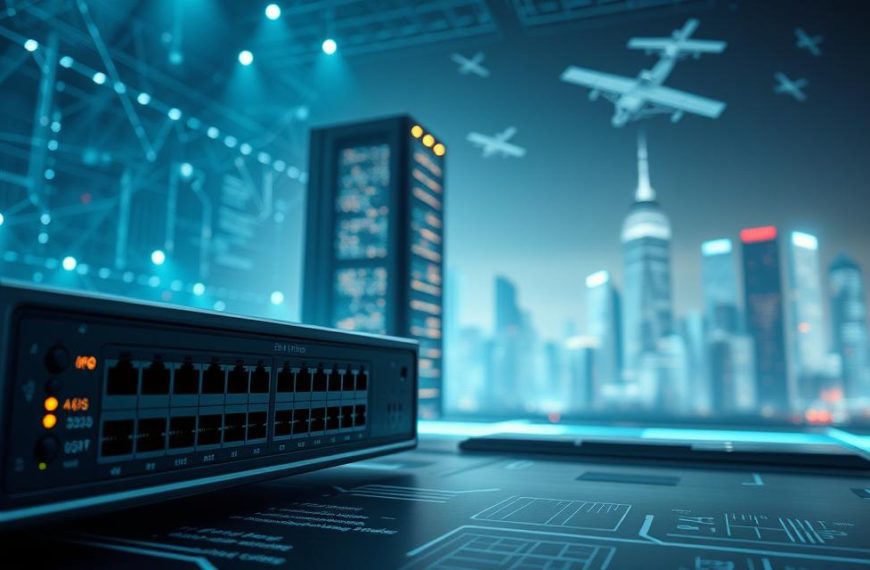Creating a strong network connection between devices changes how we work and team up. It’s vital in both home networks and office networks. Easy access to other computers opens up a lot of possibilities.
This feature makes sharing resources and working together on projects easy. You can quickly get to shared files and use devices on other computers.
Our detailed guide shows you how to get a smooth local network access. You’ll discover useful tips that work on various operating systems and network setups.
Our expert tips will help you solve common connection problems. Make your digital workspace better with reliable communication between devices today.
Understanding Network Fundamentals
Before you start connecting computers, it’s key to know the basics of networks. This knowledge helps you fix problems and make smart choices about your network.
What Constitutes a Local Network
A Local Area Network, or LAN, is a group of devices in a small area. This could be your home, office, or school. LANs are small, usually covering a few kilometres.
Devices on a LAN share things like printers and internet. This setup is fast and secure. You can control who accesses your network.
Different Network Types and Their Characteristics
There are many network types, each for a different purpose. A Wide Area Network (WAN) is big, covering cities or countries. The internet is the biggest WAN, reaching everywhere.
Wireless Local Area Networks, or Wi-Fi, are popular for their ease. They use radio waves to connect devices. Many networks mix wired and wireless for flexibility.
Each network type has its own features:
- LAN: Fast, small, cheap to set up
- WAN: Wide, slower, more expensive
- Wi-Fi: Wireless, easy but less secure
How Computers Communicate Within Networks
Networks use rules called protocols for communication. These rules help devices talk to each other, no matter who made them. Think of them as a common language.
Every device has a unique IP address. This is like a postal address, helping data packets find their way. Without IP addresses, devices can’t talk to each other.
The process of communication involves a few steps. First, devices find each other. Then, they agree on how to connect. After that, they exchange data in a way that ensures it’s received correctly.
Knowing these basics makes setting up networks easier. You’ll understand why certain steps are needed and how to fix problems.
Essential Prerequisites for Network Connections
Before you can connect to other computers, make sure everything is set up right. This step is key for smooth and safe network use between devices.
Network Hardware Requirements
Good hardware is the base of a solid network. The right stuff keeps your devices talking to each other without a hitch.
Router and Switch Specifications
Your network’s heart is a modem for the internet and a router for directing traffic. For bigger setups, a switch can add more Ethernet ports. Make sure your router supports the latest wireless standards for top-notch performance.
Cabling and Wireless Standards
For wired links, the quality of your Ethernet cable matters a lot. Cat6 cables are better than Cat5e, moving data faster. For wireless, adapters that support 802.11ac or Wi-Fi 6 (802.11ax) are best for speed and reliability.
Software and System Configuration
Software setup is just as important as hardware. It lets devices find and talk to each other on the network.
Operating System Requirements
All computers need to run supported operating systems. Windows 10 or newer, macOS Catalina or later, and current Linux versions are usually the best. Keep your systems up to date for better security and performance.
Network Discovery Settings
Turn on network discovery on devices you want to connect. This lets computers see each other. In Windows, you can do this through essential network settings and tasks in the Control Panel.
Security Considerations
Don’t overlook network security. The right settings keep your data and devices safe from unwanted access.
Firewall Configurations
Set up your firewall settings to let in good traffic and block bad stuff. Windows Firewall has rules for sharing files and printers. Make sure you have the right exceptions for network use.
User Permissions and Access Rights
Sort out user permissions before you start connecting. Each computer needs user accounts with passwords. Shared resources need the right access rights. Use the least privilege principle to limit access to what’s needed.
For wireless networks, use a strong security key with WPA3 encryption if you can. Change your router’s admin password to stop unauthorized changes.
How to Connect to a Computer on My Network – Step-by-Step Methods
Connecting computers on your network opens up many possibilities. You can share files, access computers remotely, and work together. This section will guide you through different connection methods for various operating systems.
Connecting via Windows Network Features
Windows has built-in tools for network connectivity. These tools are powerful and easy to use. They help you access shared resources on your network.
Using File Explorer for Network Browsing
The Windows File Explorer is the simplest way to find computers on your network. Open File Explorer and select “Network” from the navigation pane. This shows all devices on your local network.
Double-click any computer icon to see its shared folders and resources. Make sure network discovery is enabled in your Network and Sharing Centre settings for access.
Mapping Network Drives in Windows 10 and 11
To connect to a shared folder permanently, map a network drive in Windows. This makes a network location appear as a local drive.
- Open File Explorer and select “This PC”
- Click “Map network drive” from the Computer tab
- Choose an available drive letter
- Enter the folder path (e.g., \\ComputerName\SharedFolder)
- Check “Reconnect at sign-in” for automatic connections
Remote Desktop Connection Setup
Windows Remote Desktop lets you control another computer on your network. First, enable Remote Desktop on the target computer through System Properties > Remote Desktop settings.
On your local machine, search for “Remote Desktop Connection” in the Start menu. Enter the computer name or IP address of the target machine and connect using appropriate credentials.
“Remote Desktop Protocol provides one of the most secure methods for remote computer access within corporate networks.”
Accessing Computers Through macOS
Apple’s macOS offers elegant solutions for network connectivity. These solutions fit well with the operating system’s design.
Finder Network Section Navigation
The macOS Finder has a Network section that shows available computers and devices. Open a new Finder window and select “Network” from the sidebar to browse connected devices.
You can view shared folders, printers, and other resources directly through this interface. Add frequently accessed locations to your Finder favourites for quick access.
Connecting to Shared Folders on Mac
To connect to a specific shared folder, select “Go” from the menu bar and choose “Connect to Server.” Enter the server address using the format smb://ComputerName/ShareName.
After authentication, the shared folder mounts on your desktop and appears in Finder locations. You can drag files directly to and from these network locations.
Screen Sharing Between Apple Devices
macOS has built-in screen sharing capabilities for remote control between Apple devices. Enable Screen Sharing in System Preferences > Sharing on the target Mac.
On your local Mac, open Finder, select Network, choose the target computer, and click “Share Screen” in the upper-right corner. Enter credentials when prompted to establish the connection.
Cross-Platform Connection Methods
When working with mixed operating system environments, several solutions bridge the compatibility gap between Windows, macOS, and Linux systems.
Using Third-Party Software Solutions
Various third-party software applications facilitate cross-platform connections with enhanced features. These tools often provide simpler setup processes than native options.
| Software | Platform Support | Primary Function | Cost |
|---|---|---|---|
| TeamViewer | Windows, macOS, Linux | Remote access and support | Free for personal use |
| AnyDesk | Windows, macOS, Linux | Remote desktop software | Freemium model |
| Parsec | Windows, macOS, Linux | Low-latency remote access | Free and paid tiers |
SSH Connections for Technical Users
For secure command-line access, SSH (Secure Shell) provides encrypted connections between computers. Install an SSH server on the target machine and use clients like PuTTY (Windows) or Terminal (macOS) to connect.
Basic SSH connection syntax: ssh username@hostname. SSH requires technical knowledge but offers robust security for administrative tasks.
Web-Based Access Options
Many modern routers and network-attached storage devices include web interfaces for accessing connected computers. These portals provide browser-based access to files and resources without installing additional software.
Check your router’s administration page for features like “Network Storage” or “File Sharing” that might offer these capabilities. Some manufacturers provide mobile apps that complement these web interfaces.
Troubleshooting Common Connection Issues
Even with the right setup, network connections can fail. This section offers solutions for common problems users face when trying to connect to their network.
Connection Failure Diagnosis
Start with basic tools if you can’t connect. These tools help figure out if the issue is with the connection or setup.
Ping and Network Testing Commands
The ping command is a good starting point. Open Command Prompt and type “ping [computer IP address]”. If you get a response, it means you’re connected physically.
For more detailed checks, use these commands:
- ipconfig: Shows your current IP settings
- tracert: Traces the path packets take to another computer
- netstat: Lists active network connections
Firewall and Antivirus Interference
Firewall blocking can stop network connections. Check your firewall settings to make sure network discovery and file sharing are allowed.
Antivirus software can sometimes block connections. Try disabling it temporarily to see if it’s the cause. Always re-enable it afterwards.
Permission and Access Problems
Authentication issues can block access even with a connection. These problems usually involve user credentials and share permissions.
Resolving Authentication Errors
When you get an authentication error, first check your username and password. They must match an account on the target computer.
For Windows networks, make sure Network Security settings are the same on all computers. Enabling NTLMv2 authentication can solve compatibility problems.
Configuring Share Permissions Correctly
Share permissions control what users can see. Right-click the shared folder, select Properties, then check the Sharing and Security tabs.
For access, set both share permissions and NTFS permissions correctly. The most restrictive permission always wins.
Network Configuration Issues
Wrong network settings can stop computers from seeing each other. These problems often need checking of basic settings.
IP Address Conflicts and Solutions
An IP conflict happens when two devices have the same IP address. This causes problems for both devices.
To fix conflicts, set static IP addresses correctly or make sure your DHCP server has enough addresses.
Workgroup and Domain Configuration
All computers must be in the same workgroup for easy discovery. Check this in System Properties and make sure the name is the same.
In business settings, domain configuration issues might need admin help. Make sure all computers can talk to the domain controller.
Conclusion
This guide has shown you how to set up reliable computer connections in your local network. You now know how to work in both Windows and macOS environments. This knowledge is key to navigating your network smoothly.
Keeping your network safe is vital. Use strong authentication and keep your systems updated to protect your data. These steps are critical for network security.
If you face network problems, don’t worry. The troubleshooting tips in this guide can help. Remember, solving issues takes time and careful effort.
Effective network management combines technical skills with a focus on security. By following these best practices, you can ensure your network is both efficient and secure.
Your network skills will grow with each new challenge. The knowledge from this guide will help you tackle more complex networking tasks in the future.

